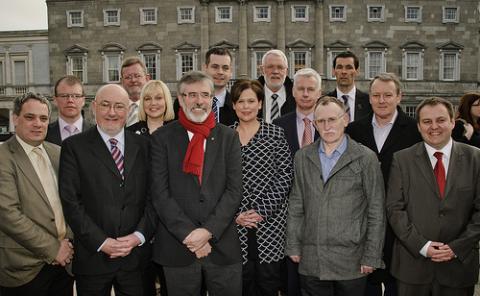Sinn Féin - moving to the centre

Granny never liked Ian Paisley. Be it radio or television, we could never hear him in full because Granny would squeal, “Waff, waff, waff, that fella!” Not that she was overtly political; it was more his demeanour, his teeth, his accent. Her hand slapping down in his direction said more of her perhaps, than it did of him.
We in the South – she as much said – were content with our three political parties and had no need with lunatics from a different sphere or with a foreign agenda. What would Granny make of Northern Politics’ current accommodation in the South?
The Northern Assembly elections this year made little impact on both sides of the border, probably because the status quo was largely maintained. Chief positions continue to be retained by incumbents Martin McGuinness and Peter Robinson, and for all intents and purposes, it is business as usual.
There were some upsets however:
- DUP splinter group, the Traditional Unionist Voice (TUV), lambasted the election of the Speaker of the assembly, as a “consequence of another sordid deal between the DUP and Sinn Féin”.
- Six days previously, Ulster Unionist Tom Elliott described Sinn Féin supporters as ‘scum‘, adding that their ‘counterparts in the IRA’ had murdered citizens, and had tried to ‘destroy this country for years’.
- The appointment of convicted murderer Mary McArdle as special advisor to the Sinn Féin Culture Minister provoked much upset, and was met with a blasé response by Gerry Murray, SF MLA, who said that ‘almost half our assembly team are former political prisoners’.
The reaction from the Dublin political establishment to Sinn Féin’s burgeoning ranks has been limp by comparison. Apart from attacking Sinn Féin on their economic expertise during the course of the General Election, most quips have been traded across the floor as part of the general argy-bargy of Order of Business or Leaders’ Questions. Nothing meaningful or cogent by any standard. If anything, the main political parties – despite the optics – are cosying up to Sinn Féin for their own short-term electoral and parliamentary gain.
It has been widely reported that a number of Fianna Fáil Seanad seats were safeguarded due to the support of Sinn Féin councillors. Fianna Fáil Senators Labhras O’Murchú and Mark Daly bring with them to the Seanad a deeper understanding of label ‘Republican Party’. This should come as no surprise, as a cursory study of both Senators’ contributions exposes certain sympathies. Consider this statement by Senator Daly in the context of the regrassing of Croke Park:
“On the 125th anniversary of the GAA, which is a great institution, it is disappointing to read in the newspapers that for the first time ever the all-Ireland hurling and football finals will be played on British soil.”
Contrast this with the fever pitch of the 1980s. A 1984 Magill article on the then Fine Gael/Labour Government’s policy towards Sinn Féin considers the dynamic that existed between the parties in the context of a Section 31 Broadcasting ban on Sinn Féin as one of the protagonists of the Troubles:
“The main result of this tougher approach is the embargo on dealings with elected public representatives who are members of Sinn Féin. It has caused intense bitterness and confusion.”
It wasn’t until 1993 that the Broadcasting embargo was lifted by the then Minister, Michael D. Higgins. Since then attitudes have mellowed towards the party, accelerated by the Good Friday agreement and the continuing peace process.
At Local Government and grassroots level, Sinn Féin continue to consolidate. Their 2009 local election result of fifty-four seats may appear relatively paltry, but they are represented in all county councils bar ten. Now with fourteen Dáil deputies and three Senators, Sinn Féin are here to stay.
Fundamentally, they have come to dress like us, they now come from and represent ’good areas’, and with an emboldened Oireachtas team, they contribute on every debate and issue of a Southern character. Far from a different sphere with an entirely foreign agenda, or known only by Northern accents, Sinn Féin are strategically positioned to become a future Dáil power.
In the soup that is the 31st Dáil; Sinn Féin are increasingly looking acceptable and palatable. Side by side with Fianna Fáil and the Independents, their credibility as opposition (and future government) parliamentarians, is on the rise. As an organised, coherent and legitimate voice of protest in the face of the economic turmoil they threaten the well that both Fianna Fáil and Labour draw from. However, the hijacking of the tri-colour and references to a 32 County Ireland continue to jar for most.
